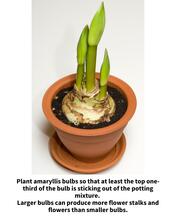
Along with evergreens and poinsettias, another sign that the holidays are approaching is the appearance of amaryllis in stores. Whether you’re buying them as gifts or for yourself, these relatively carefree plants are a great way to add a splash of color indoors.
Amaryllis (Hippeastrum spp.) are large bulbs, often 2-5 inches in diameter. The bulbs will produce large (four-to-ten-inch) trumpet-shaped flowers on long, hollow stalks (1 to 2 feet long). The flowers can be single or double, and range from red, salmon, pink, and white to bicolor and are often striped or mottled. The large strap-like leaves are typically produced around the time the flowers begin to open.
What to look for when purchasing bulbs
When it comes to selecting amaryllis bulbs, size matters. Larger bulbs will have more stored energy, which means they will be able to produce more flowers. Larger bulbs also tend to produce thicker, stronger stems. Like other bulbs, make sure they are firm and don’t have any mold, decay, or injury signs.
Planting and care of amaryllis bulbs
Many of the amaryllis plants available this time of year come pre-potted (make sure the pots have drainage holes) and are ready to go. You’ll occasionally find some that have already started to grow, and all you need to do is give them some light and water. However, if you buy an unpotted amaryllis bulb, there are a few things you need to do to get it growing and off to a good start.
Plant the bulb in a pot with drainage holes that is about one inch wider than the bulb. Ideally, the pot should also be twice as tall as the bulb, so there is adequate space for root development.
Select a soil-less (well-draining) potting mix and plant the bulb so that at least the top one-third of the bulb is sticking out of the potting mixture. It’s a good idea to leave about an inch of space between the top of the soil and the top of the pot, so water does not spill out while watering.
Once planted, water your amaryllis thoroughly and allow excess water to drain from the pot (doing this in a sink may be a good idea). Then place your plant in a sunny window. You’ll want to keep your soil moist but not soggy. Wait to water until the top two inches of soil feels dry.
Once the flower buds start to show color, move the plant out of direct sunlight and ideally into a cooler location. Moving the plant will help retain the blossoms for a longer period of time.
What to do after they bloom
While people often treat them as annuals, you can get amaryllis to rebloom next year. As flowers begin to fade, cut them off to prevent seed formation. Allowing seeds to form will deplete energy resources and can lead to reduced blooming in subsequent years. Wait to remove the flower stalk until it begins to yellow. The flower stalk can photosynthesize (like leaves) and create energy/food that will be stored for future flower growth.
You’ll also want to leave the leaves of your amaryllis. As with other bulbs, like tulips and daffodils, the leaves are needed to create energy/food so the plants can bloom again.
After your amaryllis is done blooming, place it in a bright indoor location (a window with southern exposure is likely the best place). Water regularly and fertilize monthly with an all-purpose houseplant or indoor plant fertilizer (follow the directions on the label).
Amaryllis can be taken outdoors once there is no longer a risk of frost. Place them in an area that receives filtered sunlight at first, and then gradually move to an area where it will get a minimum of six hours of sunlight a day. Continue to water and fertilize as needed. In the fall, bring the amaryllis indoors before the first frost.
How do I get amaryllis to rebloom?
Amaryllis don't require a dormant period to rebloom; however, forcing a bulb into dormancy can help control when they will rebloom. This can be done by placing them in a cool (45 to 55°F), dark location. The bulb will need to go through a resting period for approximately eight to twelve weeks before it can be forced to bloom again. During this time, do not water the plants. Once the leaves become yellow, they can be removed.
While in this resting period, periodically inspect the bulbs. If they begin to grow, place them in a sunny window. If they don’t start to grow on their own, you can force new growth by watering the soil thoroughly and putting them back into a warmer, sunny location. When bulbs show signs of growth, resume watering and fertilizing. Flowers will usually develop about 4-6 weeks after this dormant period.
What about waxed amaryllis bulbs?
Waxed amaryllis are a relatively new trend. When bulbs are waxed, the roots are removed, and a wire is inserted into the bottom of the bulb. This wire allows the bulb to stand up on its own. The bulb is then sealed in wax, often red, green, or white. Since the bulbs are sealed in wax, they don’t need to be watered or placed in soil or a pot.
These plants are typically intended to be thrown away after blooming. However, it may be possible to plant them with a little work. Remove the wax and wire from the bulbs. If the bulb is still firm, it can be planted and cared for like other amaryllis bulbs.
Good Growing Facts of the Week: Despite their common name, the plants we call amaryllis aren’t true amaryllis. Rather, they are plants from the genus Hippeastrum, which are native to Central and South America. True Amaryllis (Amaryllis spp.) are native to Africa.
There are around 90 species of Hippeastrum. However, most of the amaryllis sold are hybrids of six different species, H. vittatum, H. leopoldii, H. pardinum, H. reginae, H. puniceum, and H. aulicum.
Want to get notified when new Good Growing posts are available? SIGN UP HERE!
Give us feedback! How helpful was this information (click one): Very helpful | Somewhat helpful | Not very helpful
MEET THE AUTHOR
Ken Johnson is a Horticulture Educator with University of Illinois Extension, serving Calhoun, Cass, Greene, Morgan, and Scott counties since 2013. Ken provides horticulture programming with an emphasis on fruit and vegetable production, pest management, and beneficial insects. Through his programming, he aims to increase backyard food production and foster a greater appreciation of insects.


